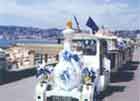
here
are all kinds of places to visit in and around Antibes
to suit all tastes.
Literally
on your doorstep at Les Trois Palmes is the
Old Town with its narrow streets and quaint, flower
bedecked houses.
There
is a number of museums and art galleries just a couple
of minutes walk away. The port, with its large yachts
and cruisers, is also just a short stroll and well
worth a visit.
Perhaps
because the houses in the Old Town are nestled together
and most do not have their own gardens, it seems
in places that the street and the walls of the houses
become the gardens. Plants and flowers climb up around
the faded shutters.
You
should not leave Antibes without visiting the Safrenier
Quarter, where the charm and tranquility of the Old
Town are perhaps greatest.
In
fact, the 10-minute walk from Les Trois Palmes through
this area, along the Ramparts with beautiful vistas
of the sea, past the Bastion Saint-André and down
to the beaches of Ponteil and Salis is a delight.
 
 |
| The
Picasso Museum |
Just
a two-minute walk from Les Trois Palmes and
built in the 16th century on the former Greek Acropolis,
the
Château Grimaldi became a museum dedicated to Picasso
after the great painter donated all the works he created
there.
 As an alternative to walking, why
not take the petit train (little train)
through the little streets to the provencal
market, Port Vauban, the ramparts, Juan les
Pins beaches and Salis beach As an alternative to walking, why
not take the petit train (little train)
through the little streets to the provencal
market, Port Vauban, the ramparts, Juan les
Pins beaches and Salis beach |
Picasso
worked at the castle during the war and materials for
painting were scarce so he painted on anything going.
When he ran out of canvas he started on the walls!
The
museum has since acquired further works by him, and
artists from several major 20th-century trends are
represented, including Gleizes, Léger, Atlan, Balthus,
Germaine Richier, Ernst, Picabia, Miro, Modigliani,
Hartung and Nicolas de Staël.
 |
| Antibes
cathedral |
Next to the Picasso Museum, the cathedral was built
in the 12th century on the site of the Roman temple
of Diana the hunting goddess. It has a 12th century
Roman choir and an 18th century baroque nave.
Very close to the provencal market and Les Trois
Palmes and part of
the old medieval walls of the city, the tower was lived in by the Gilli family,
a family of fishermen, for more than a century and now houses popular arts
and crafts of the 18th and 19th centuries. |